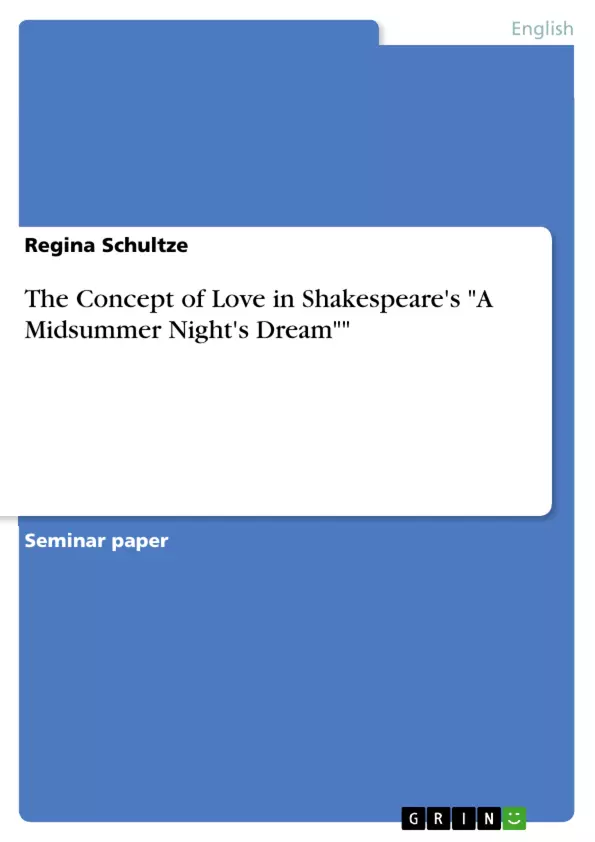William Shakespeare surely is one of the most important English authors – although he lived 500 years ago, his works are still read and discussed. Since 1897, well over 200 films and countless television programmes adapted from Shakespeare’s plays were produced . Especially his comedies enjoy great popularity.
Because this paper will deal with one of Shakespeare’s comedies, it is necessary to clarify the term “comedy”. In Shakespeare’s century, a comedy was everything that was not a tragedy or a historical play – so the term was as neutral as our German ‘Schauspiel’ is. The intended effect of a comedy was to “frame your mind to mirth and merriment, which bars a thousand harms and lengthens life” , so to evoke laughter and entertainment with a therapeutic intention. In addition to that, comedies had a didactic function: they should show general mistakes like thoughtlessness, quarrelsomeness and meanness in the form of exaggeration.
The main theme of the Shakespearean comedy is love. This paper will deal with “A Midsummer Night’s Dream” (written in 1595 or 1596) with a special attention to the play’s couples. Their state of relationship and the language the lovers use will be in the foreground. Does it differ from normal language use? If so, do the couples all speak in the same way? Does the language differ from couple to couple, in dependency of their quality of relationship?
Firstly, it will be explained how the Elizabethan concept of love works. Secondly, it is demonstrated how a crush is revealed in terms of language and how a lover’s language develops in Shakespeare’s play. To conclude, the film version of Michael Hoffmann from 1999 will be looked at with special regards to a comparison of play and film.
Inhaltsverzeichnis (Table of Contents)
- Introduction
- The Elizabethan Concept of Love
- The Literary Language of Love in Shakespeare's "A Midsummer Night's Dream"
- Lysander and Hermia
- Demetrius and Helena
- Oberon and Titania
- Theseus and Hippolyta
- Conclusion
- Literature
Zielsetzung und Themenschwerpunkte (Objectives and Key Themes)
This paper examines the portrayal of love in William Shakespeare's "A Midsummer Night's Dream", focusing on the play's various couples and their language. It aims to investigate how the Elizabethan concept of love, rooted in ancient humoral theory, is reflected in the play's dialogue. The paper explores whether the language of love differs between couples and whether it reflects the stage of their relationships.
- The Elizabethan concept of love and its underlying humoral theory
- The use of language to express love and its different stages
- The portrayal of love in "A Midsummer Night's Dream" and its variations across different couples
- The influence of external factors on love and relationships
- The comparison of Shakespeare's original text with a film adaptation.
Zusammenfassung der Kapitel (Chapter Summaries)
The introduction sets the context by discussing Shakespeare's enduring popularity and the definition of comedy in his era. It introduces the concept of love as the central theme of Shakespearean comedy and specifically focuses on the portrayal of couples in "A Midsummer Night's Dream."
Chapter 2 delves into the Elizabethan concept of love. Drawing on the ideas of Hippocrates and Galen, the chapter explains how love was understood as a physical and emotional experience influenced by humors and the elements. It explores different types of love and the six stages of falling in love.
Chapter 3 examines the literary language of love in "A Midsummer Night's Dream." It discusses the importance of eloquence and beauty in expressing love and how language can be used to manipulate emotions. The chapter then focuses on specific couples in the play, analyzing their dialogue and contrasting their language with other couples.
Schlüsselwörter (Keywords)
The paper explores keywords such as Elizabethan love, humoral theory, language of love, Shakespearean comedy, "A Midsummer Night's Dream", couples, dialogue, and film adaptation. It aims to provide a comprehensive analysis of the play's portrayal of love within the context of Elizabethan thought and literary conventions.
- Quote paper
- Regina Schultze (Author), 2008, The Concept of Love in Shakespeare's "A Midsummer Night's Dream"", Munich, GRIN Verlag, https://www.grin.com/document/156021



